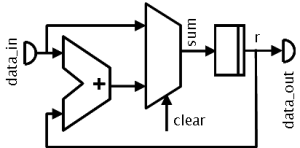Table of Contents
The Component
In Arx, the component is the basic building block of hardware, comparable to a module in Verilog or the entity-architecture combination in VHDL.
Example 1: Register
The code below shows one of the simplest components that one could describe in Arx (say, the hello world of Arx). It represents a single register. So, at each rising edge of the clock the component copies the data at its input to its output.
- copy.arx
component top T_IO : generic type = bitvector(8) data_in : in T_IO data_out : out T_IO register storage : T_IO = 0 begin storage = data_in data_out = storage end
The code contains the following information:
- The component is called
top. - All signals in this component have data type
T_IO. It is a generic type which means that the type can be given a value at instantiation time. - The default value of
T_IOisbitvector(8)which represents a bundle of 8 binary signals numbered 7 down to 0. The page dedicated to Arx data types gives more information on available data types. data_inis an input signal of the component as indicated by the keywordin.data_outis an output signal of the component as indicated by the keywordout.- Even when the component is synchronous, the clock and reset signals are not explicit. They will be automatically added to the generated VHDL code. The page on C-based simulation explains how to deal with clock and reset when using the generated C-code for simulation.
- The component contains a register called
storagewith the same width asdata_inanddata_out. data_inconnects to the input of this register, anddata_outto the output.- The equal sign
=represents a signal assignment, a connection from the right-hand side to the left-hand side. - The equal sign
=is also used to specify the reset value of registers. The language requires that all registers have a reset value. - Assignments to registers follow the semantics of synchronous systems (see the page on RTL). A register in the right-hand side of an assignment produces the value clocked into the register after the last rising edge of the clock. A register in the left-hand side of an assignment refers to the next value that will be clocked in.
Example 2: A Clearable Accumulator
The example below is a somewhat more sophisticated design. Next to a register, it has some combinational logic. It represents a clearable accumulator which adds a sequence of numbers and outputs the result.
- reg-cascade.arx
component top wl: generic integer = 12 T_in : generic type = signed(wl , 1) T_out: generic type = signed(wl-2, 1, sat, round) T_sum: generic type = signed(wl+5, 6) clear: in bit data_in : in T_in data_out: out T_out variable sum: T_sum register r: T_sum = 0 begin if clear == 1 sum = data_in else sum = r + data_in end r = sum data_out = r end
Remarks:
- The component has two internal signals: register
rand wiresum. Wires (signals that do not keep their value across clock cycles) are declared after keywordvariable. - The data type used for the data path is fixed-point.
- The intended behavior of this circuit is that inputs are accumulated in a register with more bits that the input, but that the output has fewer bits. The latter requires handling of overflow and quantization (in this case saturation and rounding) which is automatically performed in the generated code (both C and VHDL). See the section on Arx data types for a detailed explanation.
- Another intended behavior is that the accumulator is cleared by directly copying the input to it when the signal
clearis high. This is expressed by the if statement which is presented in more detail in the section on Arx statements. - The picture below depicts the circuit implied by this description (without the signal data types).
General Structure
The pseudo-code below lists all possible constituents of a component.
component <component name> <generic declarations> <generic type declarations> <i/o declarations> <constant declarations> <type declarations> <register declarations> <variable declarations> <subcomponent instantiations> begin <statements> end
Known Issues
The top-level component needs to be called top in the current version
of Arx.


